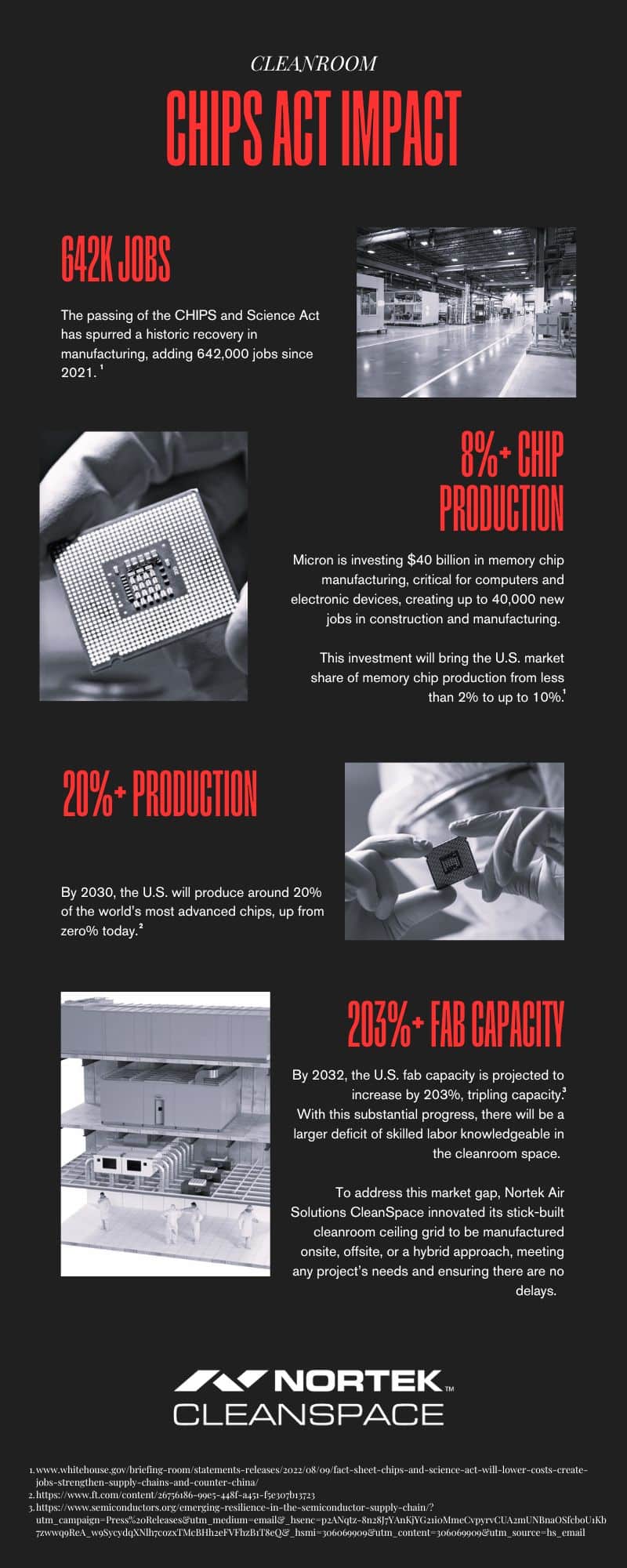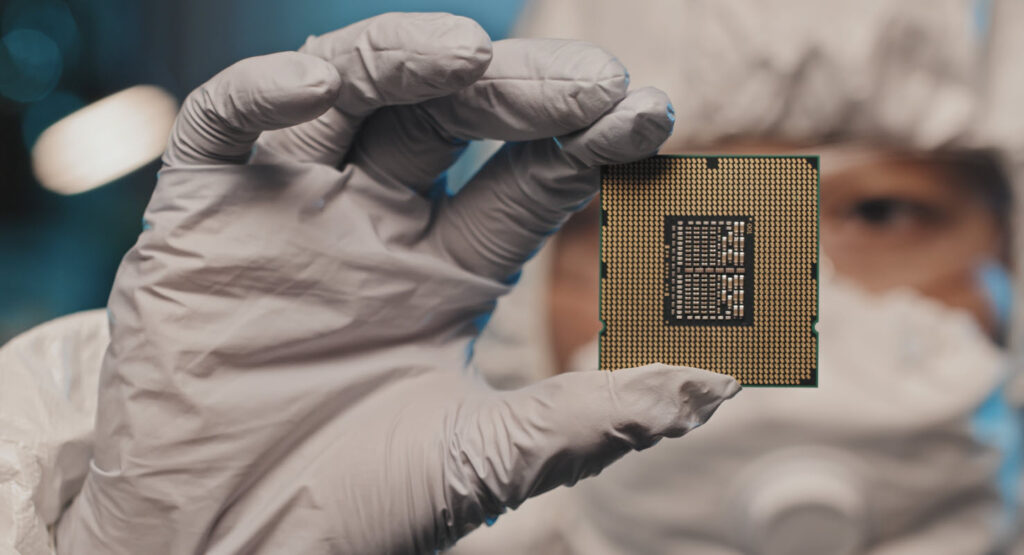Cleanroom Construction: Navigating The CHIPS Act Impact
With the passing of the CHIPS Act (Creating Helpful Incentives to Produce Semiconductors for America), the U.S. is forecasted to grow its capabilities in critical technology segments, such as leading-edge fabrication, DRAM memory, analog, and advanced packaging. The recent Semiconductor Industry Association’s recent report states the U.S. capacity for advanced logic will grow from 0% in 2022 to 28% by 2032, including new capabilities at the leading edge. The impact of the CHIPS Act on cleanroom demand and design is significant. Here's how the CHIPS Act is influencing cleanroom demand and design:
Supply Chain Pressure:
The CHIPS Act provides funding, which may increase supply chain pressure for materials and components. The CHIPS Act aims to mitigate some of these issues by promoting domestic production, but supply chain resilience remains a concern as the demand increases. Cleanroom operators, engineers, and contractors should inquire about product lead times with manufacturing partners of critical components to ensure that the projects remain on time and budget. For example, the average lead time for air handling units is 24 weeks. At Nortek CleanSpace, our teams work to keep our lead times between 12 and 20 weeks consistently.
Skilled and Experienced Labor Gap:
With the increased demand for cleanrooms under The CHIPS Act, the already strained skilled labor pool will be further challenged. Micron recently announced an investment of $40 billion in memory chip manufacturing, which will require an additional 40,000 new jobs in construction manufacturing alone. Cleanroom construction has historically been a labor-intensive endeavor, with ceiling grid installation representing a significant portion of both time and resources.
In response to these challenges, offsite manufacturing—or modular construction—has emerged as a popular approach to cleanroom ceiling grid projects. Offsite manufacturing involves the prefabrication of components in a controlled factory environment, followed by assembly and installation at the construction site.
Key elements of offsite manufacturing include:
- Precision Engineering: Offsite manufacturing facilities utilize advanced technologies such as Building Information Modeling (BIM) Revit design, and automated machinery to ensure precise measurements and high-quality fabrication. This precision minimizes errors and ensures consistency across all components.
- Streamlined Production: By centralizing production in a dedicated facility, offsite manufacturing eliminates the inefficiencies associated with on-site construction. Workflow optimization, standardized processes, and just-in-time delivery mechanisms enhance productivity and minimize project timelines.
- Quality Assurance: Offsite manufacturing allows for strict quality control protocols, including regular inspections and testing procedures by experts that are familiar with cleanroom design and manufacturing. This commitment to quality ensures that prefabricated components meet or exceed industry standards, reducing the risk of defects or structural issues that may occur with onsite manufacturing.
Partner Expertise Becomes Paramount
When it comes to designing your cleanroom, architects commonly use a platform for BIM called Revit. Collaboration between your cleanroom manufacturer and architect and mechanical and electrical disciplines ensures that the space is designed correctly and eliminates future hurdles. It’s important that all manufacturing partners not only understand BIM tools but have a team of engineers trained to implement solutions, like the cleanroom ceiling system. This ensures that the project has more refined designs that integrate into the space seamlessly. This additional design expertise can be critical to keeping projects on time and budgets.
There are two common approaches for constructing cleanroom ceiling grids: modular ceiling grids and stick-built ceiling grids. There are key differences between these two systems and the top considerations for selecting the right solution for your cleanroom application.
Modular Ceiling Grids
Modular ceiling grids support an off-site manufacturing model, as they are fully assembled at the factory and delivered complete, ready to be installed. These modules are designed to be compatible with the cleanroom's layout, requirements, and provide:
- Faster Speed of Installation: Modular ceiling grids are known for their rapid installation process, as most components are welded at the factory and ready for assembly on-site. This can significantly reduce construction timelines, minimizing downtime during cleanroom setup or renovations.
- Precision and Consistency: Since modular components are factory-made, they tend to have higher precision and consistency in terms of measurements and quality, resulting in a more predictable cleanroom environment.
- Customized Components: Although modular systems are standardized, they often offer customization options to accommodate specific cleanroom requirements, such as wiring, lighting, fire protection, and enhanced walkability. Some manufacturers also offer bottom loading and top loading options, which provide flexibility with various overhead clearances and room-side or top-side ceiling access to components.
- Field Labor Cost-Efficiency: Modular Ceilings are easier and faster for onsite teams to install, which can lead to cost savings around installation.
Stick-Built Ceiling Grids
Stick-built ceiling grids provide more flexibility to retrofit into existing spaces and delivery options that fit your construction site needs. Stick-built solutions leverage individual components like structural supports, grid systems, and ceiling sections that provide:
- Flexibility in Design: Stick-built systems provide greater flexibility in design and layout, allowing for adjustments and modifications during the construction process. This can be advantageous in unique cleanroom configurations and retrofitting.
- Hybrid Construction Model: Unlike modular solutions that are welded, stick-built solutions are bolted assembly, giving more flexibility to construction and delivery. With a hybrid construction model, a manufacturer should be able to deliver the ceiling grid pre-assembled, flat packed semi-built, or ready to be built on site.
- Cost Shifts: While the overall cost of stick-built solutions is often lower than modular ceiling grids, the installation labor is more intensive and could result in a higher chance of installation errors.
Considerations for Selecting the Right Ceiling Grid Solution
In many instances, both a modular and stick-built ceiling solution will meet the needed class ratings, reliability, and functionality needed. So how do you select the right solution? The considerations often come down to:
- Project Timeline: Consider the urgency of your cleanroom setup or renovation. If time is critical, modular ceiling grids may be the better choice due to their quicker installation. Consider if there are any site restrictions that may require offsite construction to keep the project moving.
- Budget: Analyze your budget constraints. Modular systems may have lower installation costs, but tend to have higher grid costs, while a stick-built grid is likely to have a lower grid cost, there are higher labor costs and expertise needed for installation.
- Future Modifications: The CHIPS Act funding could mean frequent modifications or expansions in your cleanroom. With anticipated expansions, a stick-built ceiling grid may be more suitable, as it allows for easy alterations. Consider a manufacturer who offers both modular and stick-built ceiling grids and has the expertise to accommodate both styles in the same facility for added customization and flexibility.
With the CHIPS Act spurring a historic recovery in manufacturing, the next several years will be a pivotal time for cleanrooms. With the right partners and taking key factors into account upfront, contractors and engineers can ensure that cleanroom construction projects remain on time, budget, and allow for any future expansion needs.
About Nortek Air Solutions CleanSpace
With world-class brands like CleanPak®, Huntair®, Temtrol®, Governair® and Mammoth® Nortek CleanSpace produces innovative, safe cleanroom solutions that meet and exceed strict contaminant and particulate-free environment standards so that customers can continue creating products that make the world safer, healthier, and more productive. Nortek Air Solutions CleanSpace has engineered over 20 million square feet of cleanroom systems that exceed strict contaminant and particulate-free regulations to keep the world’s most innovative spaces running.

